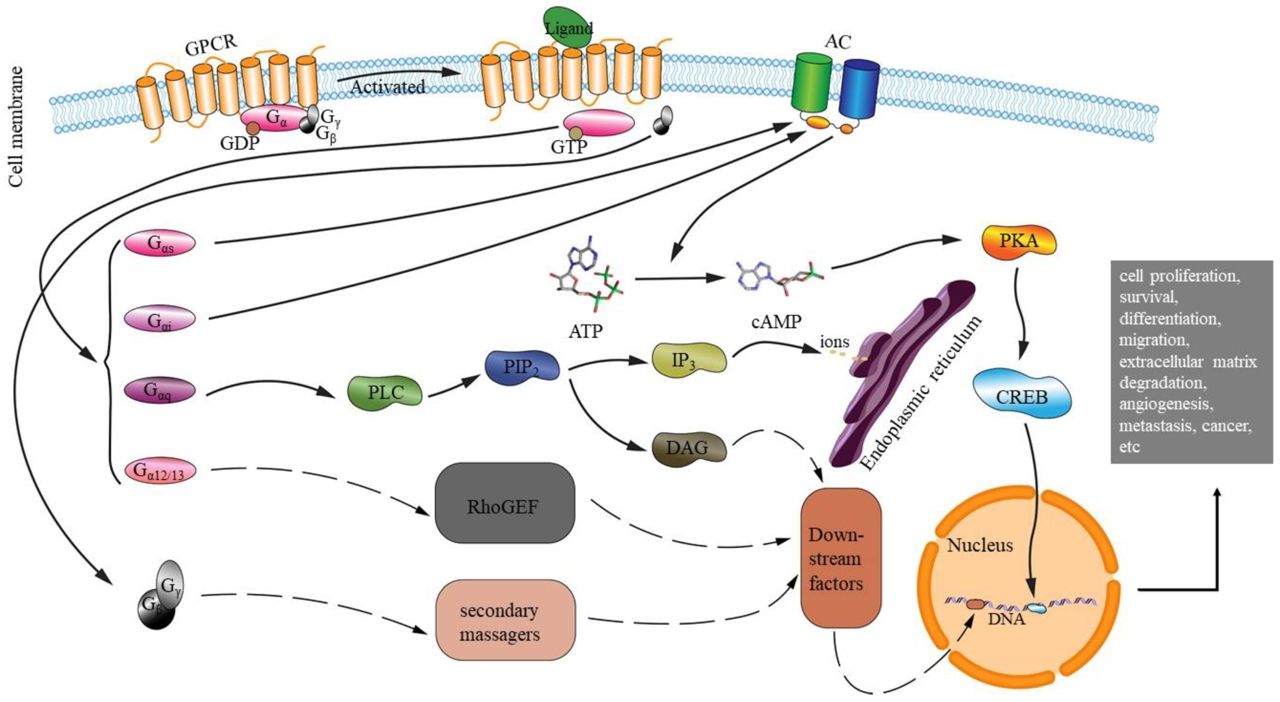Hi-Affi™ Multiplex GPCR Cell Line
G-protein-coupled receptors (GPCR), known as 7 transmembrane receptors, are the largest family of cell surface receptors and account for approximately 4% of the protein-coding human genome. They participate in a variety of important physiological functions and are considered one of the most successful therapeutic targets for a broad spectrum of diseases. Therefore, GPCRs represents the largest family of druggable targets for therapeutic interventions, constituting over 50% of the current therapeutic agents on the market. Given their appealing properties and great therapeutic potential, Creative Biolabs has established an innovative Hi-Affi™ GPCR cell line platform to study compound functionalities in early development stage. Incorporated with a unique biosensor system, GPCR activities can be monitored via second messenger molecules (i.e. Ca2+, DAG, cAMP). In addition, currently we also provide a full range of Hi-Affi™ GPCR multiplex cell lines capable of detecting multiple pathway activities.
GPCR Signaling Pathways
GPCRs can be activated by a wide range of stimulants, including light, odorant, molecules, peptide, hormones, cytokines, lipid, etc., thus playing a key role in diverse physiological processes. GPCR signaling is a complicated, highly-regulated network, involving a wide spectrum of physiological events. In presence of continuous agonist stimulation, GPCRs are phosphorylated by specific GPCR kinases (GRKs), which will eventually terminate G protein signaling and lead to a coordinated process of receptor desensitization, inactivation, and internalization.
 Fig.1 Graphical representation of the locations of GPCR regulatory pathways.1, 2
Fig.1 Graphical representation of the locations of GPCR regulatory pathways.1, 2
It's been proved that many GPCRs can activate multiple G proteins simultaneously, termed signaling multiplicity. From a drug discovery perspective, the potential for agonist trafficking, a phenomenon in which certain agonists exert different efficacies in activating one pathway over another, may be a critical consideration in functional screening for GPCR agonist/antagonist. If a single functional assay capturing only one signaling pathway is performed, potentially valuable compounds will be probably missed if the compound does have functional selectivity. Furthermore, G-protein-independent signaling, can also add to the multiplicity of receptor signaling. Therefore, it is extremely necessary to develop and implement multiple screenings in an early drug discovery campaign.
Hi-Affi™ Multiplex GPCR Cell Lines
An ideal receptor function screening for GPCR ligand should be simple, nonradioreactive, robust, homogenous, and well-compatible to high throughput, high content format. Creative Biolabs used a special biosensor system that can respond to second messenger activities (cellular translocation). By co-expressing a certain GPCR and fluorescent biosensors on U2OS cell surface, Hi-Affi™ GPCR stable cells can real-time detect and quantify GPCR activation/inhibition in an efficient, convenient and sensitive format. In contrast to single-pathway capture, we also provide multiplexing cell lines co-expressing 2 biosensors in different colors, i.e. cAMP and Ca2+, cAMP and DAG, DAG and Ca2+, constituting an excellent tool for multiplicity compound screening/validations. By simultaneously investigating two pathways in a single assay, this system can be particularly useful to identify GPCR biased ligands, which activate only one GPCR cellular pathways and greatly enhance the chances to find potentially ideal leads.
Attractive Advantages
Combined with our years of experience and expertise in GPCR research, our Hi-Affi™ multiplex GPCR cell lines are engineered to characterize with multiple attractive advantages (as follows), paying the way to serve as a valuable tool for drug discovery and development.
- Simultaneous monitoring of multiple signaling pathways to comprehensively understand GPCRs' functions and evaluate potential side effects and drug interactions.
- Simultaneous monitoring of multiple endpoints provides more robust and reliable data.
- Efficient screening of large compound libraries.
- Cost-effective and time-saving.
- Compatible for a full range of GPCRs.
- Excellent cell quality under rigorous quality control.
Empowered by our leading-edge technologies and extensive experience, Creative Biolabs is committed to providing professional assistance to accelerate custom projects of GPCR drug discovery. Now we offer high-quality Hi-Affi™ biosensor cell line options to assess calcium-, cAMP-, DAG-related as well as multiplex pathway events of various GPCRs. One-stop custom service to generate custom GPCR cell line is also available. Please don't hesitate to contact us for more information.
References
- Liu, Nannan, et al. "G-protein coupled receptors (GPCRs): signaling pathways, characterization, and functions in insect physiology and toxicology." International Journal of Molecular Sciences 22.10 (2021): 5260.
- under Open Access License CC BY 4.0, without modification.
For Research Use Only.
